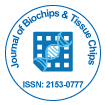Make the best use of Scientific Research and information from our 700+ peer reviewed, Open Access Journals that operates with the help of 50,000+ Editorial Board Members and esteemed reviewers and 1000+ Scientific associations in Medical, Clinical, Pharmaceutical, Engineering, Technology and Management Fields.
Meet Inspiring Speakers and Experts at our 3000+ Global Conferenceseries Events with over 600+ Conferences, 1200+ Symposiums and 1200+ Workshops on Medical, Pharma, Engineering, Science, Technology and Business
Editorial Open Access
Biosensors Technology
| Jan Halamek* | |
| Department of Chemistry and Biomolecular Science, 214 Science Center, Clarkson University, Potsdam, NY 13699-5810, USA | |
| Corresponding Author : | Jan Halamek Department of Chemistry and Biomolecular Science 214 Science Center Clarkson University Potsdam, NY 13699-5810, USA Tel: 1-315-268-2354 (-2370) Fax: 1-315-268-6610 E-mail id:jhalamek@clarkson.edu |
| Received May 22, 2012; Accepted May 25, 2012; Published May 28, 2012 | |
| Citation: Halamek J (2012) Biosensors Technology. J Biochips Tiss Chips 2:e112. doi:10.4172/2153-0777.1000e112 | |
| Copyright: © 2012 Halamek J, et al. This is an open-access article distributed under the terms of the Creative Commons Attribution License, which permits unrestricted use, distribution, and reproduction in any medium, provided the original author and source are credited. | |
Visit for more related articles at Journal of Bioengineering and Bioelectronics
| Biosensorics, initiated more than 40 years ago, became an established and an important area of biotechnology in the last decade – it currently represents a mature and adequate analogue to “classical” instrumental techniques, especially in areas like clinical or on-field diagnostics and it is leading technology in point-of-care analysis. |
| The definition of biosensor was frequently noted in literature and can be simplified as follows: a device based on functional and structural combination of a bioreceptor – a biological recognition element, and a transducer – a sensor. The transducer is converting the effect created by the interaction of the bioreceptor with the analyte, usually into an electrical signal. The major advantage of all of these processes is the high specificity of the biorecognition of a single selected analyte. Depending on the definition of these events – bio-interaction and signaltransduction, biosensors can be divided into many different classes. The mode of signal transduction can be electrochemical, optical, resonant (acoustic), thermal etc. Commonly used biological receptors are antibodies, enzymes, nucleic acids, but also tissues or whole living cells. Typically, the bioreceptor – usually immobilized on/within the surface of transducer – acts as a catalyst when interacting with the analyte, while remaining unchanged. This is typical for enzyme based biosensors. On the other hand, in the case of affinity -based biosensors, where bioreceptors are usually represented by antibodies or nucleic acids, the binding of complementary nucleic acid or appropriate antigen causes a one-time response effect. |
| As can be seen, there are two significant trends, among others, in the area of biosensorics. First, significant performance improvement of biosensors that are already established. A typical example is the glucose biosensor, of which reliability and sensitivity have been significantly improved over the last 15 years. The second trend is a development of novel types of biosensing approaches, based on new non-traditional materials, e.g. Carbon Nanotubes (CNT), or different conductive polymers. Remarkable electrical and structural properties of these materials enabled new options mainly in the area of electrochemical sensing technologies. |
| However, new strategies are not always based only on novel materials but also on different sensing methodology. Evidence of such kinds of innovation is the recently emerging field of biomolecular computing (Biocomputing), where biologically-inspired sensing systems are used to perform various computing operations that mimic processes typical of electronic computing devices. Such approaches, with their sophisticated biomolecular design, have resulted in reversible, reconfigurable, and resettable “bio-logic” sensing architectures (gates) for processing chemical information, especially in biosensor applications where, until now, a simultaneous analysis of several different species has been necessary to be carried out by biosensor or bioassay arrays. Scaling up the systems could result in artificial bio-computing networks with an increased complexity which can develop into areas of novel multi-input biosensors. |
| Biosensor technology already offers a unique combination of performance and analytical features not available in any other bioanalytical system. The listing of just a few options in this overview can encourage future interdisciplinary efforts, which could yield new generations of biosensors for a wide range of applications. |
Post your comment
Relevant Topics
Recommended Journals
Article Tools
Article Usage
- Total views: 13332
- [From(publication date):
September-2012 - Apr 05, 2025] - Breakdown by view type
- HTML page views : 8808
- PDF downloads : 4524
